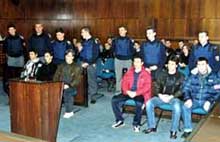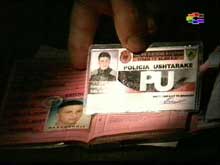|
Enter content here VfL Wolfsburg's Martin Petrov, right, from Bulgaria, fights for the ball with Borussia Dortmund's Czech player Jan Koller, left, during the German first division soccer match in Wolfsburg, northern Germany, on Saturday, Feb. 2, 2002. (AP Photo/Fabian Bimmer) Accused Claim to Have Been "NLA Soldiers" Having Nothing to do With "ANA" Reality Macedonia - Vest 
Convicted Albanian terrorists in court. The proceedings against six members of the terrorist ANA got underway on February 1 in the Skopje First Instance Court 1. They have been charged with undertaking anti-state activities and trafficking weapons. According to the accusation, on November 11, last year, Izair Samii, Nuhi Mustafi, Muzafer Zekiri, Jakupi Arben, Bejtula Jetmir and Shkodran Idrizi plotted an attack against Macedonian security forces. They were intercepted by the police at around 4 pm near the Tetovo village of Trebosh. Arrest procedure of the suspects. Click on the image to see more images from this event, courtesy of SITEL TV. Upon checking their IDs and their three cars, the police found three automatic rifles, three guns, a revolver and ammunition. Nitrate particles were detected on the hands of the accused Izair Zekiri and Shkodran, which means they had been using fire arms. In the preliminary investigation, they all defended themselves with silence. 
Confiscated "NLA" "military police" ID card, indicating higher-ranking membership of the suspects. Of the six accused, the first-accused Izair and the fifth-accused Bejtula admitted before the Court to have been members of the terrorist NLA. They also claimed they had never taken part in armed conflicts and only had membership cards and served as ordinary soldiers. Asked by the Court about the origin of his automatic rifle, Izair explained: "It was not an entirelly automatic rifle, but it had small bullets, and the bad situation in the region was the reason why I kept it in the car. I bought it in Kosovo last summer." He told the Court he had never fired a shot because his right hand had been severely injured by a grenade in the village of Poroj. The second accused Mustafi Nuhi admitted before the Court to have had a rifle. On November 11, he transferred the weapons from his vehicle to Jetmir Bejtula’s car and hid the clip in one of the compartments of the car. However, Bejtula, the driver of the vehicle, said in his statement: "I swear (with Albanian besa) that no weapons were hidden in the compartment." The third-accused Muzafer Zekiri explained that he had bought a gun because he had been harassed by racketeers several times. As for shooting, he said he fired but a single shot at a wedding two weeks before his arrest. On the day he was arrested, he was cleaning his gun and therefore nitrate particles were later found on his hands. AK-47 assault rifle under the passenger seat. One of the suspects belonged to the Albanian gang that tortured the five kidnapped workers in August, but he's been pardoned for that thanks to the Amnesty. The fourth-accused Jakupi Arben, student at the self-styled Mala Rechica School of Law, said it was a coincidence he was in the vehicle because he had only asked the others to drive him home. The sixth-accused Shkodran said he had a gun that was given to him as a present because of being small and interesting. He also claimed to have fired a single shot just for fun. Shkodran is said to have been one of those who tortured the kidnapped workers of the Mavrovo construction company, for which he has been pardoned. Abdurahman Aliti, PDP member of parliament, also appeared in the Court. Nobody, however, confirmed if one of the accused is his nephew. After the hearing of Samii Izair, he left the trial. ----------------------------------------------------------------------------------------- Besa - an Albanian oath, word of honor, or pledge. According to propagated tradition, the besa is sacred and inviolable. You can get the feel about this concept by reading some Albanian folk stories, especially those that include inconsequential breaking of the besa and glorification of extermination of non-Albanians. Christo's Oversized Art in Focus. AP By CARL HARTMAN, Associated Press Writer
WASHINGTON (AP) - How does a museum put on a show for an artist when one of his typical works included 2,050 panels of fabric? It was called ``Running Fence'' and stretched more than 24 miles across two California counties.
Answer: It takes imagination - and a lot of patience.
Thinking big and creating big are what distinguish the collaboration of Christo, the man who specializes in oversized art, and his wife of more than 40 years, Jeanne-Claude.
They're developing two new projects now: to hang seven miles of a silvery canopy over a rafters' river in Colorado; and to erect 11,000 steel frames over the walkways in New York's Central Park, with panels of saffron-colored nylon streaming from them.
What his projects look like can be seen in 61 Christo drawings, models, lithographs and early works, the first survey exhibit in the United States devoted to his sculpture. They were given to the National Gallery of Art by Herbert and Dorothy Vogel, who assembled the biggest collection of Christo works in the United States.
The exhibit opens at the gallery Sunday and remains until June 23.
Before he starts either of his new works, Christo will need to get permission from the government's Bureau of Land Management for Colorado; and from New York City's Parks Department for Central Park.
Getting needed permits for a Christo work often takes longer than building it. One of the couple's most recent was to drape 1,076,000 square feet of aluminum-coated cloth over the Reichstag, Germany's parliament building in Berlin, which they began planning in 1971 and completed in 1995.
``We were tortured through 25 years and six presidents of the Bundestag,'' Jeanne-Claude told a new conference this week. ``It proves one thing: politicians go; art remains.'' The Bundestag, modern Germany's parliament, moved back into the pre-World War II Reichstag when the government moved back to Berlin from Bonn, former capital of West Germany, in 1999.
The Reichstag remained wrapped for two weeks in 1995, and 5 million people went to see it. The artists refused a request to extend the exhibition. Jeanne-Claude calculated they spent $13 million on the project over the years and paid $150,000 rent ``to the German nation'' for permission to do the job.
``We spend everything we have to build our projects'' she said. ``The money comes from the sale of works - indoor works - that we own, created by the hand of Christo who works alone in his studio.''
Jeanne-Claude said their outdoor works are collaborations, but indoor works are by Christo alone.
``I do not know how to draw,'' she explained but said she handles all the couple's dealings with accountants.
Born in Bulgaria, Christo - full name: Christo Vladimirov Javacheff - trained at the Sofia Fine Arts Academy, then in Vienna and in Paris. He and Jeanne-Claude de Guillebon, who was born in Morocco, were born on the same day, June 13, 1935. They met in Paris and now are citizens of the United States, living in a fifth-floor walk-up in downtown Manhattan.
The Reichstag package was the culmination of Christo's early career in wrapping things: statues, oil drums, even a small section of Australia's coastline. Mocking his own specialty, he once sent a fellow artist a package with a note inside to say that the addressee had destroyed a work of art in opening it.
In a reporters' tour of the Washington exhibit, Christo explained that he wrapped a lot of recent history in his Reichstag project: the great fire that gave Adolf Hitler an excuse for taking broad power in Germany; its bombardment and capture by the Soviets at the end of World War II; and its uncertain status in the postwar years on the border of the divided capital, visible from both West Berlin and the Communist-controlled eastern part of the city.
The Reichstag was restored before the Bundestag, united Germany's federal parliament, moved in.
Christo's full title for the wrapped Reichstag incorporates the inscription on the building's facade: ``To the German People.'' |



